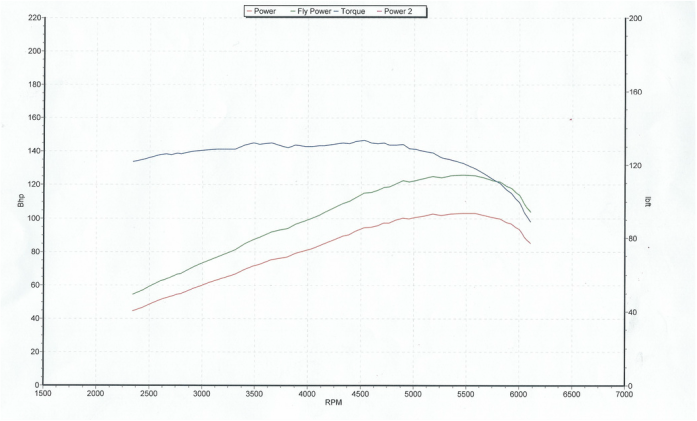The precise contents of the motor are a mystery to me although it is has always seemed reasonably meaty. Kaj told me that it had been built by a reputable MG expert in Denmark, and Kaj is an MG guy and he should know. I can see that it has an 18V head, single Weber etc - but beyond that only a note suggesting it has a Piper 285 cam. Oh, and a photograph of a dyno run showing peak power of about 120bhp.
Since the summer I have also had a problem with plug-fouling. The car would tickover like a bag of crisps and, absent a blast, the plugs were carbon-covered. It seemed so rich that I figured the car behind me on the hill might just about have run up there on my fumes. This was at least attenuated when I ditched the exotic NGK plugs featuring electrodes modelled on hypodermic needles, and with a coating of pure red kryptonite that might explain their cost.
But, having spent 15 years working only with injection and management-systems, and forgetting anything I might ever have known about carburation, it was time to get the car onto some rollers with some old skool help. That saw me heading to Ricky G. near Huntly. For those unfamiliar with the geography of Scotland, this translates as 'quite far up there'.
The result left me no better informed about what is in the lump. But a lot happier with its delivery.
Since the summer I have also had a problem with plug-fouling. The car would tickover like a bag of crisps and, absent a blast, the plugs were carbon-covered. It seemed so rich that I figured the car behind me on the hill might just about have run up there on my fumes. This was at least attenuated when I ditched the exotic NGK plugs featuring electrodes modelled on hypodermic needles, and with a coating of pure red kryptonite that might explain their cost.
But, having spent 15 years working only with injection and management-systems, and forgetting anything I might ever have known about carburation, it was time to get the car onto some rollers with some old skool help. That saw me heading to Ricky G. near Huntly. For those unfamiliar with the geography of Scotland, this translates as 'quite far up there'.
The result left me no better informed about what is in the lump. But a lot happier with its delivery.
Ricky has been racing Imps for 'several' decades. But the latest incarnation of his own car features Jenvey ITB's and DTA management, so he is not stuck in the past.
It was a treat, and a lesson in methodology, to watch him run through all the steps to identify and correct possible ignition problems, and any fuelling issues upstream of the carb. The points were in poor shape because of burned protection film that should have been cleaned off before putting them into service, and fuel pressure was low when measured at the Weber banjo. Static advance also seemed to be retarded, so he wound-in some more advance.
We leafed through a few references I had for possible jetting scenarios from the old Special Tuning booklet, Peter Burgess's book etc before Ricky stuck the car on the rollers. Shuttling through some new jetting combinations, we settled on something with larger main and smaller air-correction jets before a final power run in the time available.
100+bhp at the wheels ('Power' in the chart) is good for one of these lumps, and the Fly Power of 120+bhp equates to the flywheel estimate of the Danish dyno chart. What I found more impressive was the shape of the torque curve, having an almost flat 130lbft flat from the south side of 3k to the north side of 5k rpm. Ricky seemed as pleased as I was, and that warranted a road-test with him perched on my toolbox, wielding the wideband lambda gauge.
Equally, the curve tails off distinctly above 5.5k rpm. And, having slept on it a bit, I wonder if we were not being overly-conservative dialling-in just 30 degrees of total advance? Maybe I'll try sneaking in a couple more degrees static just to try it....
It was a treat, and a lesson in methodology, to watch him run through all the steps to identify and correct possible ignition problems, and any fuelling issues upstream of the carb. The points were in poor shape because of burned protection film that should have been cleaned off before putting them into service, and fuel pressure was low when measured at the Weber banjo. Static advance also seemed to be retarded, so he wound-in some more advance.
We leafed through a few references I had for possible jetting scenarios from the old Special Tuning booklet, Peter Burgess's book etc before Ricky stuck the car on the rollers. Shuttling through some new jetting combinations, we settled on something with larger main and smaller air-correction jets before a final power run in the time available.
100+bhp at the wheels ('Power' in the chart) is good for one of these lumps, and the Fly Power of 120+bhp equates to the flywheel estimate of the Danish dyno chart. What I found more impressive was the shape of the torque curve, having an almost flat 130lbft flat from the south side of 3k to the north side of 5k rpm. Ricky seemed as pleased as I was, and that warranted a road-test with him perched on my toolbox, wielding the wideband lambda gauge.
Equally, the curve tails off distinctly above 5.5k rpm. And, having slept on it a bit, I wonder if we were not being overly-conservative dialling-in just 30 degrees of total advance? Maybe I'll try sneaking in a couple more degrees static just to try it....

 RSS Feed
RSS Feed